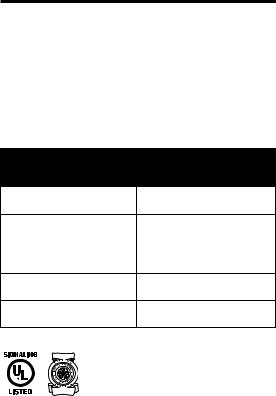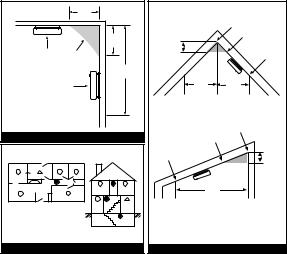Kidde i9010 User Manual

i9010 |
For model: i9010 |
|
|
|
|
|
|
Smoke Alarm User’s Guide
Lithium (non-replaceable sealed in) Battery-Operated Smoke Alarm with Alarm Memory and SMART HUSHTM Control to temporarily silence nuisance alarms.
Thank you for purchasing this smoke alarm. It is an important part of your family’s home safety plan. You can trust this product to provide the highest quality safety protection. We know you expect nothing less when the lives of your family are at stake.
For your convenience, write down the following information. If you call our Consumer Hotline, these are the first questions you will be asked.
Smoke Alarm Model Number (located on back of alarm):
Date Code (located on back of alarm): The National Fire Protection Association (NFPA) and the manufacturer recommend replacing this alarm
ten years from the date code.
Date of Purchase:
Where Purchased:
Manual P/N 21008311-EN Rev. A
0910-7225-00
This alarm detects products of combustion using the ionization technique. It contains 0.9 microcurie of Americium 241, a radioactive material (see Section 9). Distributed under U.S. NRC License
No. 32-23858-01E. Manufactured in compliance with U.S. NRC safety criteria in 10 CFR 32.27. The purchaser is exempt from any regulatory requirements. Do not try to repair the smoke alarm yourself. Refer to the instructions in Section 12 for service.
IMPORTANT! READ ALL INSTRUCTIONS BEFORE INSTALLATION AND KEEP THIS MANUAL NEAR THE ALARM FOR FUTURE REFERENCE.
CONTENTS OF THIS MANUAL
1 -- RECOMMENDED LOCATIONS FOR SMOKE ALARMS
2 -- LOCATIONS TO AVOID
3 -- INSTALLATION INSTRUCTIONS
4 -- OPERATION AND TESTING
5 -- NUISANCE ALARMS
6 -- MAINTENANCE
7 -- LIMITATIONS OF SMOKE ALARMS
8 -- GOOD SAFETY HABITS
9 -- NRC INFORMATION
10 -- NFPA PROTECTION STANDARD 72
11 -- CALIFORNIA STATE FIRE MARSHAL REQUIRED INFORMATION
12 -- SERVICE AND WARRANTY
1. RECOMMENDED LOCATIONS FOR ALARMS
•Locate the first alarm in the immediate area of the bedrooms. Try to monitor the exit path as the bedrooms are usually farthest from the exit. If more than one sleeping area exists, locate additional alarms in each sleeping area.
•Locate additional alarms to monitor any stairway as stairways act like chimneys for smoke and heat.
•Locate at least one alarm on every floor level.
•Locate an alarm in every bedroom.
•Locate an alarm in every room where electrical appliances are operated (i.e. portable heaters or humidifiers).
•Locate an alarm in every room where someone sleeps with the door closed.

The closed door may prevent an alarm not located in that room from waking the sleeper.
•Smoke, heat, and combustion products rise to the ceiling and spread horizontally. Mounting the smoke alarm on the ceiling in the center of the room places it closest to all points in the room.
Ceiling mounting is preferred in ordinary residential construction.
•For mobile home installation, select locations carefully to avoid thermal barriers that may form at the ceiling. For more details, see
MOBILE HOME INSTALLATION below.
•When mounting an alarm on the ceiling, locate it at a minimum of 4” (10 cm) from the side wall (see figure 1).
•When mounting the alarm on the wall, use an inside wall with the top edge of the alarm at a minimum of 4” (10 cm) and a maximum of 12” (30.5 cm) below the ceiling (see figure 1).
•Put smoke alarms at both ends of a bedroom hallway or large room if the hallway or room is more than 30 feet (9.1 m) long.
|
|
4" |
|
CEILING |
|
(10 cm) |
|
|
MINIMUM |
|
|
|
|
DEAD AIR |
|
|
|
SPACE |
4" |
|
|
|
|
|
|
|
(10 cm) |
|
|
|
MINIMUM |
|
BEST |
NEVER |
|
|
HERE |
HERE |
|
|
|
|
|
|
|
|
12" |
|
|
|
(30.5 cm) |
|
|
|
MAXIMUM |
|
ACCEPTABLE |
|
|
|
HERE |
|
|
|
|
|
SIDE |
|
|
|
WALL |
|
|
FIGURE 1 |
|
|
|
MULTIPLE |
|
SINGLE FLOOR PLAN |
FLOOR PLAN |
||
BEDROOM KITCHEN |
BEDROOM BEDROOM |
|
|
|
|
BEDROOM |
HALL BEDROOM |
LIVING ROOM |
BEDROOM |
|
|
|
|
LIVING |
KITCHEN |
|
|
ROOM |
|
|
|
BASEMENT |
|
NOT |
FIGURE 2 |
|
|
IN THIS |
|
|
|
|
NOT |
|
IN THIS |
|
AREA |
4" |
ANYWHERE |
(102 mm) |
IN THIS |
|
AREA |
3' |
3' |
(0.9 m) |
(0.9 m) |
|
NOT |
|
IN THIS |
|
AREA |
ANYWHERE |
4" |
IN THIS AREA |
|
|
(102 mm) |
|
3' |
(0.9 m) |
|
FIGURE 3
•Install Smoke Alarms on sloped, peaked or cathedral ceilings at or within 3ft (0.9m) of the highest point (measured horizontally).
NFPA 72 states: “Smoke alarms in rooms with ceiling slopes greater than 1 ft in 8 ft (.3m in 2.4 m) horizontally shall be located on the high side of the room.” NFPA 72 states: “A row of detectors shall be spaced and located within 3 ft (0.9m) of the peak of the ceiling measured horizontally” (see figure 3).
MOBILE HOME INSTALLATION
Modern mobile homes have been designed and built to be energy efficient. Install smoke alarms as recommended above (see figures
1 and 2).
In older mobile homes that are not well insulated compared to present standards, extreme heat or cold can be transferred from the outside to the inside through poorly insulated walls and roof.
This may create a thermal barrier which can prevent the smoke from reaching an alarm mounted on the ceiling. In such units, install the smoke alarm on an inside wall with the top edge of the alarm at a minimum of 4” (10 cm) and a maximum of 12” (30.5 cm) below the ceiling (see figure 1).
If you are not sure about the insulation in your mobile home, or if you notice that the outer walls and ceiling are either hot or cold, install the alarm on an inside wall. For minimum protection, install at least one alarm close to the bedrooms. For additional protection, see SINGLE FLOOR PLAN in figure 2.
WARNING: TEST YOUR SMOKE ALARM OPERATION AFTER MOBILE HOME HAS BEEN IN STORAGE OR UNOCCUPIED AND AT LEAST ONCE A WEEK DURING USE.
2. LOCATIONS TO AVOID
•In the garage. Products of combustion are present when you start your automobile.
•Less than 4” (10cm) from the peak of an “A” frame type ceiling.
•In an area where the temperature may fall below 40ºF or rise above 100ºF, such as garages and unfinished attics.
•In dusty areas. Dust particles may cause nuisance alarm or failure to alarm.
•In very humid areas. Moisture or steam can cause nuisance alarms.

•In insect-infested areas.
•Smoke alarms should not be installed within 3 ft (.9m) of the following: the door to a kitchen, the door to a bathroom containing a tub or shower, forced air supply ducts used for heating or cooling, ceiling or whole house ventilating fans, or other high air flow areas.
•Kitchens. Normal cooking may cause nuisance alarms. If a kitchen alarm is desired, it should have an alarm silence feature or be a photoelectric type.
•Near fluorescent lights. Electronic “noise” may cause nuisance alarms.
•Smoke alarms are not to be used with detector guards unless the combination (alarm and guard) has been evaluated and found suitable for that purpose.
3. INSTALLATION INSTRUCTIONS
CAUTION: THIS UNIT IS SEALED (INCLUDING THE BATTERY). THE COVER IS NOT REMOVABLE!
1.To insure aesthetic alignment of the alarm with the hallway or wall, the “A” line on the
mounting bracket should be |
|
Alignment Marks |
||
parallel with the hallway when |
|
(”A” Line) on |
||
|
Bracket |
|||
|
|
|
|
Mounting |
ceiling mounting or horizontal |
|
|
||
when wall mounting. |
A |
A |
||
|
|
|
|
When wall |
|
|
|
|
mounting, the |
|
|
|
|
“A” line should |
|
|
|
|
be horizontal. |
|
|
|
|
FIGURE 5 |
|
|
When mounting |
A |
A |
|
|
|
|
|
|
|
in a hallway, the |
|
|
A |
A |
“A” line should |
|
|
|
|
be parallel with |
Remove |
|
|
|
the hallway. |
|
|
|
|
|
|
Install |
|
FIGURE 4 |
|
FIGURE 6 |
|
